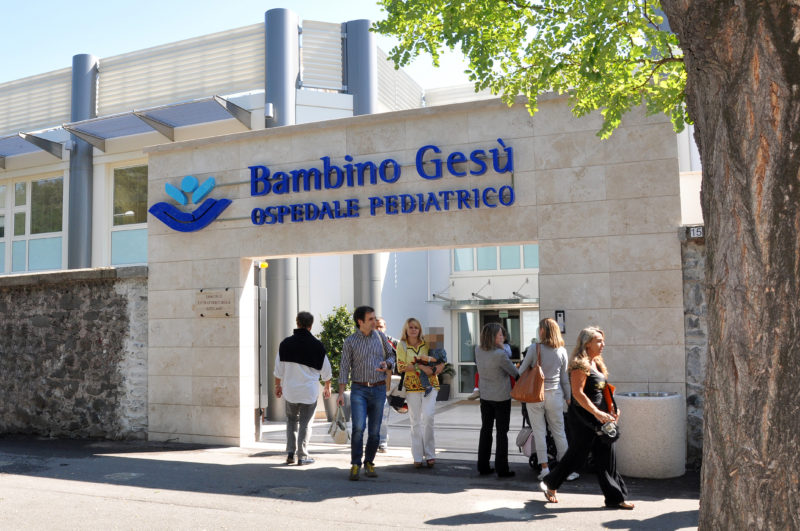HERE YOU FIND PICTURES AND VIDEO
A team of cardiac surgeons at the Bambino Gesù Children’s Hospital, in Vatican City, saved the life of a 3-year old baby girl whose heart was failing by implanting a miniaturized heart pump, developed with funding from the United States National Institutes of Health (NIH), precisely to care for the smallest infants and children for whom existing devices were not working. This is the second surgery of the kind in the world, both performed at the same hospital.
The doctors received authorization from the U.S. Food and Drug Administration and the Italian Ministry of Health for use of the miniaturized implantable ventricular assist device (Jarvik 2015 VAD), for which a clinical trial will soon start in the U.S.
The device is 15mm in diameter and weighs 50g. It was developed by the Pumps for Kids, Infants, and Neonates (PumpKIN) program of the National Heart, Lung, and Blood Institute (NHLBI), part of the NIH, as a response to the lack of circulatory support devices that could be used for some of the smallest of children awaiting a transplant because of congenital heart defects or advanced heart failure.
The goal of the program was to develop the first implantable heart assist pump for infants under 25 kg. The FDA has recently approved a pilot trial of the new device, developed by Jarvik Heart, Inc., which overcame several technical obstacles to eventually provide a device with excellent results in preclinical studies.
“The NHLBI started the PumpKIN program in 2004 to fund the development and clinical evaluation of the Jarvik 2015 VAD and other similar devices because small children with failing hearts had so few options to help them survive at that time,” saidTimothy Baldwin, M.D., NHLBI project officer for the PumpKIN program. “That is still true today. Given all the efforts to arrive at this point, the apparent success of this first-in-human implant at Bambino Gesù Hospital is very gratifying. As we prepare for the clinical trial in the United States, this experience will help us better understand how the device performs and how to best care for the fragile patients to be supported with the Jarvik 2015 VAD.”
During the 14-year duration of the PumpKIN project, the FDA has authorized the export of the device for use only twice. The first, in April 2012, involved an earlier version of the device called the Infant Jarvik 2000. On that occasion, the authorization was granted to the Bambino Gesù Hospital to save the life of a 16-month old child waiting for transplant.
The current 3-year old patient has dilated cardiomyopathy, an enlarged heart that has difficulty pumping, and is on the waiting list for a heart transplant. She had already received a Berlin Heart Excor Pediatric VAD, which is in clinical use around the world. Based on signs that her heart may have recovered function while on the device, the surgeons removed the Berlin Heart only to discover that her heart had not recovered enough to support her body’s needs. The child could not have another Berlin Heart because of infection risk. At that stage, the only possibility to save her life was the use of Jarvik 2015, the only completely implantable ventricular assist device for children this small.
Therefore, after receiving the requisite approvals from the FDA, the Italian Ministry of Health, and the Ethics Committee, Antonio Amodeo, M.D. and his team performed the surgery on February 2nd. The child was extubated 10 days after the surgery. Now, she is stable, eating pasta with her family and playing on an iPad, as she awaits heart transplantation.
Unlike any other VADs used for small children, the miniaturized Jarvik 2015 VAD implanted in a child sits completely within the chest and is powered by an external battery through a narrow cable that crosses the skin. This feature will allow patients to go home, which is important because many children on heart transplant lists wait for many months until a compatible organ becomes available.
The device is made of a pump about the size of an AA battery that is inserted into the left side of the heart and propels blood to the rest of the body. The device will support the circulation in patients weighing 8 Kg to 30 Kg, which is approximately the weight of children from 1 to 10 years old, but also may be suitable for use in smaller children. Within a few months, a clinical trial for the use of the device will begin in the United States. The Bambino Gesù Hospital will be the leader of the European Project to obtain CE certification for this device.
“If the forthcoming clinical trials confirm the lower morbidity and mortality associated with the device, this will be a real revolution in the field of pediatric mechanical cardiopulmonary support,” explains Antonio Amodeo, M.D. the physician in charge for ECMO, mechanical cardiopulmonary support, and heart transplantation at the Bambino Gesù Hospital. “In the last 20 years, only the Berlin Heart EXCOR VAD has been available and, although patients supported using it have a survival rate of 70%, because the device sits outside the body, children are not allowed to go home from the hospital while being supported by the device. With the Jarvik 2015 VAD, now patients waiting for heart transplant will have the possibility of going back home to their families after the implantation surgery which will, in turn, reduce the burden of travel to and from the hospital for the family and the patient costs for staying at the hospital. This change is particularly critical because the majority of pediatric patients needing mechanical cardiopulmonary support are under 3 years of age and this new heart pump will be used especially for these children.”



